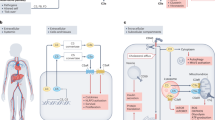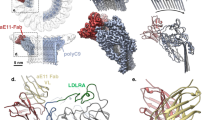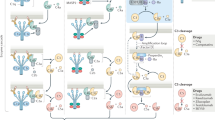Abstract
The complement system comprises a complex array of enzymes and non-enzymatic proteins that is essential for the operation of the innate as well as the adaptive immune defence1. The complement system can be activated in three ways: by the classical pathway which is initiated by antibody–antigen complexes, by the alternative pathway initiated by certain structures on microbial surfaces, and by an antibody-independent pathway2 that is initiated by the binding of mannan-binding lectin (MBL; first described as mannan-binding protein3) to carbohydrates. MBL is structurally related to the complement Cl subcomponent, Clq, and seems to activate the complement system through an associated serine protease known as MASP (ref. 4) or p100 (ref. 5), which is similar to Clr and Cls of the classical pathway. MBL binds to specific carbohydrate structures found on the surface of a range of microorganisms, including bacteria, yeasts, parasitic protozoa and viruses6, and exhibits antibacterial activity through killing mediated by the terminal, lytic complement components7 or by promoting phagocytosis8. The level of MBL in plasma is genetically determined9–11, and deficiency is associated with frequent infections in childhood12,13, and possibly also in adults14,15 (for review, see ref. 6). We have now identified a new MBL-associated serine protease (MASP-2) which shows a striking homology with the previously reported MASP (MASP-1) and the two Clq-associated serine proteases Clr and Cls. Thus complement activation through MBL, like the classical pathway, involves two serine proteases and may antedate the development of the specific immune system of vertebrates.
This is a preview of subscription content, access via your institution
Access options
Subscribe to this journal
Receive 51 print issues and online access
$199.00 per year
only $3.90 per issue
Buy this article
- Purchase on SpringerLink
- Instant access to full article PDF
Prices may be subject to local taxes which are calculated during checkout
Similar content being viewed by others
References
Law, S. K. A. & Reid, K. B. M. Complement 2nd edn (ed. Male, D.) 1–88 (IRL, Oxford, 1996).
Ikeda, K., Sannoh, T., Kawasaki, N., Kawasaki, T. & Yamashina, I. Serum lectin with known structure activates complement through the classical pathway. J. Biol Chem. 262, 7451–7454 (1987).
Kawasaki, T., Etoh, R. & Yamashina, I. Isolation and characterisation of a mannan-binding protein from rabbit liver. Biochem. Biophys. Res. Commun. 81, 1018–1204 (1978).
Matsushita, M. & Fujita, T. Activation of the classical complement pathway by mannose-binding protein in association with a novel Cls-like serine protease. J. Exp. Med. 176, 1497–1502 (1992).
Ji, Y.-H. et al. Activation of the C4 and C2 components of complement by a proteinase in serum bactericidal factor, Ra reactive factor. J. Immunol. 150, 571–578 (1993).
Turner, M. W. Mannose-binding lectin: the pluripotent molecule of the innate immune system. Immunol. Today. 17, 532–540 (1996).
Kawasaki, N., Kawasaki, T. & Yamashina, I. A Serum lectin (mannan-binding protein) has complement-dependent bactericidal activity. J. Biochem. 106, 483–489 (1989).
Kuhlman, M., Joiner, K. & Ezekowitz, R. A. B. The human mannose-binding protein functions as an opsonin. J. Exp. Med. 169, 1733–1745 (1989).
Sumiya, M. et al. Molecular basis of opsonic defect in immunodeficient children. Lancet 337, 1569–1570 (1991).
Lipscombe, R. J. et al. High frequencies in African and non-African populations of independent mutations in the mannose binding protein gene. Hum. Mol. Genet. 1, 709–715 (1992).
Madsen, H. O. et al. A new frequent allele is the missing link in the structural polymorphism of the human mannan-binding protein. Immunogenetics 40, 37–44 (1994).
Super, M., Thiel, S., Lu, J., Levinsky, R. J. & Turner, M. W. Association of low levels of mannan-binding protein with a common defect of opsonisation. Lancet ii, 1236–1239 (1989).
Garred, P., Madsen, H. O., Hofmann, B. & Svejgaard, A. Increased frequency of homozygosity of abnormal mannan-binding-protein alleles in patients with suspected immunodeficiency. Lancet 346, 941–943 (1995).
Summerfield, J. A. et al. Mannose binding protein gene mutations associated with unusual and severe infections in adults. Lancet 345, 886–889 (1995).
Nielsen, S. L., Andersen, P. L., Koch, C., Jensenius, J. C. & Thiel, S. The level of the serum opsonin, mannan-binding protein in HIV-1 antibody-positive patients. Clin. Exp. Immunol. 100, 219–222 (1995).
Baatrup, G., Thiel, S., Isager, H., Svehag, S. E. & Jensenius, J. C. Demonstration in human plasma of a lectin activity analogous to that of bovine conglutinin. Scand. J. Immunol. 26, 355–361 (1987).
Sato, T., Endo, Y., Matsushita, M. & Fujita, T. Molecular characterization of a novel serine protease involved in activation of the complement system by mannose-binding protein. Int. Immunol. 6, 665–669 (1994).
Endo, Y., Sato, T., Matsushita, M. & Fujita, T. Exon structure of the gene encoding the human mannose-binding protein-associated serine protease light chain: comparison with complement Clr and Cls genes. Int. Immunol. 9, 1355–1358 (1996).
Tan, S. M. et al. Improvements on the purification of mannan-binding lectin and demonstration of its Ca2+-independent association with a Cls-like serine protease. Biochem. J. 319, 329–332 (1996).
Jensenius, J. C., Andersen, L., Hau, J., Crone, M. & Koch, C. Eggs: conveniently packaged antibodies. Methods for purification of yolk IgG. J. Immunol. Meth. 46, 63–66 (1981).
Barton, G. J. Protein multiple sequence alignment and flexible pattern matching. Meth. Enzymol. 183, 403–428 (1990).
Takada, E., Takayama, Y., Hatsuse, H. & Kawakami, M. A new member of the Cls family of complement proteins found in a bactericidal factor, Ra-reactive factor, in human serum. Biochem. Biophys. Res. Commun. 196, 1003–1009 (1993).
Journat, A. & Tosi, M. Cloning and sequencing of full-length cDNA encoding the precursor of human complement component Clr. Biochem. J. 240, 783–787 (1986).
Lytus, S. P., Kurachi, K., Sakariassen, K. S. & Davie, E. W. Nucleotide sequence of cDNA coding for human complement Clr. Biochemistry 25, 4855–4863 (1986).
Mackinnon, C. M., Carter, P. E., Smyth, S. J., Dunbar, B. & Fothergill, J. E. Molecular cloning of cDNA for human complement component Cls. The complete amino acid sequence. Eur. J. Biochem. 169, 547–553 (1987).
Tosi, M., Duponchel, C., Meo, T. & Julier, C. Complete cDNA sequence of human complement CIS and close physical linkage of the homologous genes Cls and Clr. Biochemistry 26, 8516–8524 (1987).
Author information
Authors and Affiliations
Rights and permissions
About this article
Cite this article
Thiel, S., Vorup-Jensen, T., Stover, C. et al. A second serine protease associated with mannan-binding lectin that activates complement. Nature 386, 506–510 (1997). https://doi.org/10.1038/386506a0
Received:
Accepted:
Issue Date:
DOI: https://doi.org/10.1038/386506a0
This article is cited by
-
Angiotensin II and post-streptococcal glomerulonephritis
Clinical and Experimental Nephrology (2024)
-
Hematopoietic stem cell transplantation-associated thrombotic microangiopathy and the role of advanced practice providers and pharmacists
Bone Marrow Transplantation (2023)
-
Proteomics analysis of serum from thymoma patients
Scientific Reports (2023)
-
Association between mannose binding lectin gene polymorphisms and clinical severity of COVID-19 in children
Molecular Biology Reports (2023)
-
Non-alcoholic fatty liver disease and liver secretome
Archives of Pharmacal Research (2022)



